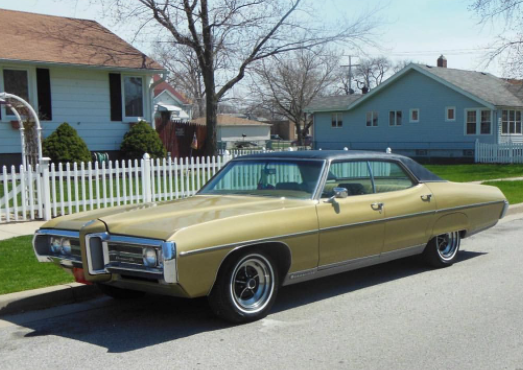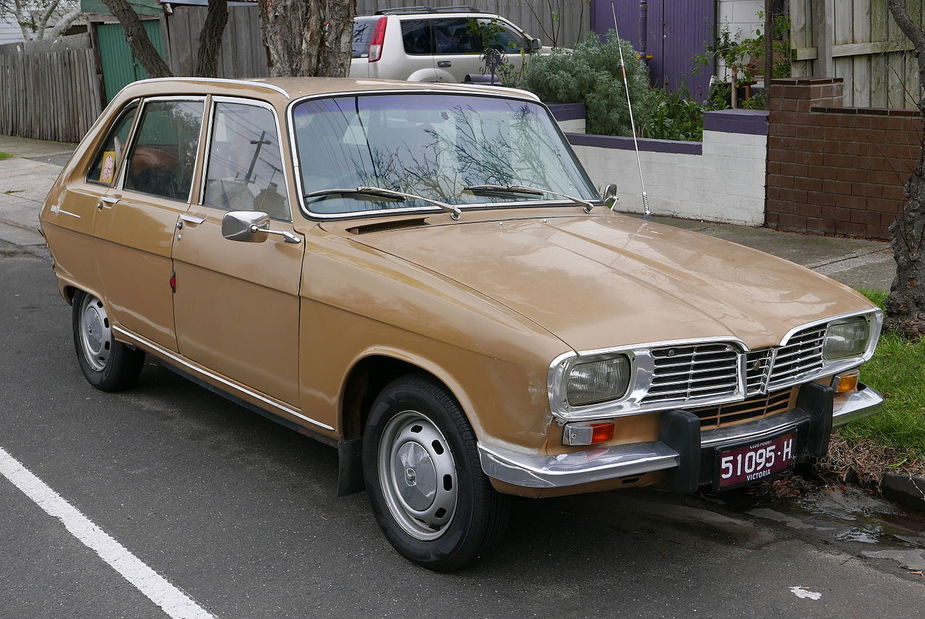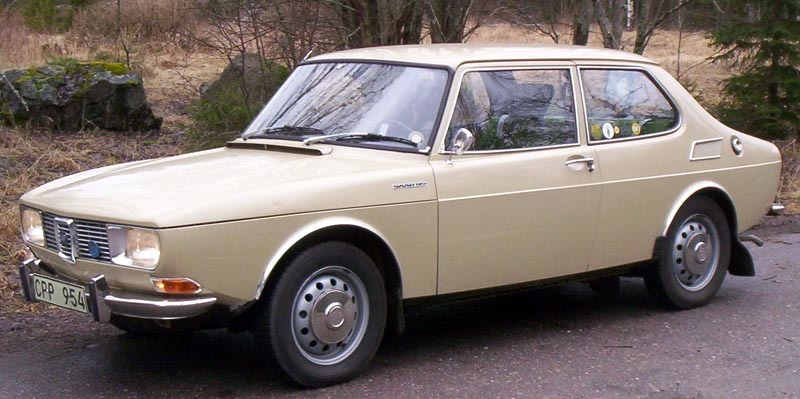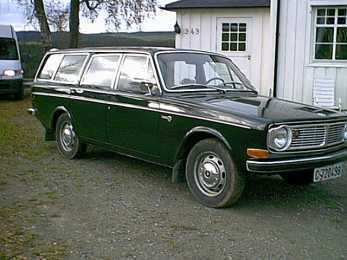Silvaire wrote:
Have you ever been to Buffalo NY in January?
No, but I have been in Calgary in December. It was winter temp alright  pretty much as around here.
pretty much as around here.
Silvaire wrote:
69 Pontiac Bonneville
I have no idea what this car looks like, googled it

Not a very practical car in the winter by the looks of it. Large, heavy, low, rear wheel drive, automatic transmission. In 69 you would get stuck everywhere in such a car. But, the heater is probably OK for cold weather? Huge engine, super low efficiency, should be no problem 
Definitely not anything you would drive in the winter on Norwegian roads in 1969, not even today. Popular cars at that time were Volvo (Amazon, 140 series), Saab 99, VW rear engine, rear drive (a gazillion Beatles around, but also others), Skoda, Renault etc rear engine, rear drive or Renault, Citroen front wheel drive were all popular. The important thing was to have the engine above the drive wheels, or else it would be a sledge in the winter. Somehow Volvo managed to make excellent cars with good traction even though they had engine up front and rear wheel drive. Today, traction control has made traction a no problem in general, and most cars have front wheel drive in any case, or four wheel drive.
Regarding heater, it was only Volvo and Saab as I can remember. VW Beatles were usually mounted with an extra fuel heater, a simple burner that burned gasoline, without that heater it was a freezer. But, this is far, far away from electric aircraft 




IIRC from my school science lessons you can only convert energy or potential energy, you cannot create it.
Eg you can create heat and power by burning fuel. But as @LeSving writes if you have more efficient engines using less fuel to power a vehicle, the heat available to the heater or to waste through the exhaust is much less.
At the same time you are trying in very cold conditions to raise the temperature much more than needed in warm conditions especially with cold air trying to cool that engine down as it drives.
There is a calculation based on joules which I am sure all you science graduates will know for water heaters and swimming pools. The calculation allows one to work out how much heat energy it takes to increase the temperature of 1 cubic metre of water (1000 litres) by 1 degree.
I think you might find that @LeSving has got it right IMO.
For sure, there is no free lunch, which is why modern diesel cars don’t divert the engine coolant into the cabin heater until the engine is warm enough – a part of the tactic to achieve a high MPG in the official tests, which petrol engined cars for some reason don’t need to bother with. Hence, I freeze in my diesel VW for the whole drive to work, whereas in any petrol car I would have a warm car halfway there.
I am sure the diesel engine produces plenty of spare heat. The manufacturers just choose to not give it to you because they get better headline numbers that way 
Now imagine electric planes. You could easily be flying in say -20C. OK; there is a greenhouse effect if you are VMC / VMC on top. But still, the already useless range will be diminished further. The 3 phase motor produces some heat but it will be low grade heat.
@LeSving nice cars! :-)
Peter wrote:
Hence, I freeze in my diesel VW for the whole drive to work, whereas in any petrol car I would have a warm car halfway there.I am sure the diesel engine produces plenty of spare heat. The manufacturers just choose to not give it to you because they get better headline numbers that way
It doesn’t have an electric heater to supplement it during the warm-up period? My last 3 cars all have done – not that I’ve ever looked into it – but it’s obviously they must do because the vents can give warm air within 5-10 secs of engine start.
Best for the mpg tests yes, but also (as I understand it) for minimising engine wear you want to reach operating temperature as soon as possible. Hence most modern engines completely close the radiator and the cabin heater until some prescribed coolant temperature is reached.
There was a common fault on one of the BMWs I had (forget the exact designation, but mine was a 2007 320d) – some secondary thermostat (not the main one – the system was complex) would fail open. If you searched the internet it was full of people complaining that they only got ~40mpg instead of 50+, and it was compounded by the fact that BMW had elected not to fit a coolant temperature gauge – part of the move away from selling to a ‘motorist’ and selling to a dumb consumer who didn’t need to know (and wouldn’t understand) such things. You had to go into the service menu on the trip computer and could get a digital readout of the coolant temp, which with this fault never went above ~72 degrees and caused poor fuel economy (as well as poor cabin heating!)
The 90 degrees at which coolant leaves the cylinder head is 10-20 degrees hotter than the flow from a typical domestic gas boiler into a central heating system. The cabin of a car is not a large space and lots of it these days (apart from the glass) is well-insulated. You don’t need a big heat exchanger in the cooling system to push an awful lot of hot air into that cabin. The key is having it well-controlled so that the system gets up to temperature before large demands are placed on it. I don’t doubt that in a simple system where the flow through the radiator was not well controlled and the heater set to max as soon as you turned the key, then in low ambient temperatures the coolant would never get really hot.
Peter wrote:
I am sure the diesel engine produces plenty of spare heat
That is a very meaningless sentence. It produces plenty of spare heat in +30 C, tons and tons of it, completely useless however (and yes, I know heat isn’t measured in tons, just in case some nitpicking German “expert” should start to argue  ) Rise the OAT to +40, and it produces even more. However, lower the OAT to -20 or more, and the spare heat is not enough to heat up the compartment. It is not without a good cause that modern cars have additional electric heaters.
) Rise the OAT to +40, and it produces even more. However, lower the OAT to -20 or more, and the spare heat is not enough to heat up the compartment. It is not without a good cause that modern cars have additional electric heaters.
For my diesel van I have a Webasto heater. Very good to heat up the car when frozen, as it heats up the water, starts the fan, heat up the compartment and defrost the windows. If you don’t know what a Webasto is, or have seen no use for it, then you don’t have a clue about cold weather operation of cars.
LeSving wrote:
Not a very practical car in the winter by the looks of it. Large, heavy, low, rear wheel drive, automatic transmission. In 69 you would get stuck everywhere in such a car.
It was a very practical car in winter, as were its ilk. Snow was not a problem. Cars like SAABs etc were driven in that era by people who didn’t mind walking, at any time of the year!
I have a lot of experience with old European cars, I worked my way through University fixing them. Some of them are a lot of fun, SAAB two strokes come to mind, but for US conditions of long distances and bad weather they were not suitable, mainly due to unreliability. I never paid much attention to the heaters, so can’t comment usefully on that.
LeSving wrote:
heat isn’t measured in tons
…although air conditioning is measured in tons, at least in the USA.
alioth wrote:
although air conditioning is measured in tons, at least in the USA

Silvaire wrote:
It was a very practical car in winter,
Oh Christ !!! LOL  But winter can be very different things of course. It’s always funny how Americans don’t understand why American cars never have been popular elsewhere. I would say it’s the lack of dry (corrosion free) and perfectly flat prairie (no turns, no hills, no bumps in the road, no nothing, and lots and lots of perfectly straight roads). Today, Tesla is indeed a very popular car, at least here in Norway, but a Tesla is very far from a typical American car, or a typical car from anywhere in fact. Even though a Tesla scores lowest on quality and faults of all cars available today, they are still very popular.
But winter can be very different things of course. It’s always funny how Americans don’t understand why American cars never have been popular elsewhere. I would say it’s the lack of dry (corrosion free) and perfectly flat prairie (no turns, no hills, no bumps in the road, no nothing, and lots and lots of perfectly straight roads). Today, Tesla is indeed a very popular car, at least here in Norway, but a Tesla is very far from a typical American car, or a typical car from anywhere in fact. Even though a Tesla scores lowest on quality and faults of all cars available today, they are still very popular.
As long as it works (to some degree). When i was at Oskosh in 2016, I rented a Ford Mustang. It was really nice to drive and looked cool. But that car on winter roads up here? maybe. It would be fun to try, as it was rather compact. The best car (overall) I have had on winter roads were in fact a BMW 320 from 2008. Rear wheel drive, but with a truly amazing artificial stability system. It even had different “modes”. Turn it off, and it became the sledge it originally was, but fun (useless in snow though). Turn it on (default), and it would balance itself through slippery turns like nothing else I have tried before and after. It did this with individual breaking on all 4 wheels, individual traction as well as modulation of the throttle pedal. Then, it could also be turned to a setting “in between”. The wheels could then spin (lose traction), but the stability was still in effect to some degree. This mode I used only a few times to drive on snow covered roads before they were plowed. In those conditions it is better to allow the wheels to lose traction, to spin. You simply need some more “freedom” than the standard traction control allow, and I think that was exactly what it was meant for.
Silvaire wrote:
It was a very practical car in winter, as were its ilk. Snow was not a problem
I’m sure in the right terrain, the land yachts would do OK, if fitted with proper winter tyres. But anywhere with hilly and curvy roads? I lived in Raleigh NC for about 6 months, during the winter, when we had quite a heavy snow fall. I had a front wheel drive Ford Contour, and I distinctly remember the feeling of schadenfreude I had while driving it down the hilly Six Forks Road, where all the RWD land yachts were stuck at the bottom of each dip, failing to get out of the dip. My sense of schadenfreude was really at the police car (a Crown Victoria, RWD of course) that got about 3/4 the way up the slope, then gracelessly slid back down to the bottom of the dip. I just had to dodge all the sliding cars in the much more surefooted Contour, which had no problem in negotiating the conditions!
The Ford Contour was Ford’s “world car”, what in Europe is known as the Mondeo.
I’ve had lot of experience with cars made virtually everywhere… although none from Australia other than test driving a ~400 HP Australian made Pontiac GTO one time  I bought a new turbo 4WD Mazda instead, long since worn out and tossed.
I bought a new turbo 4WD Mazda instead, long since worn out and tossed.
American cars were very practical transportation in all weathers from the 50s on, about 30 years ahead of cars made in Europe. European cars had better handling in general as a result of smaller and tighter roads where they were made, but with a few exceptions they were unreliable until the 80s unless driven low mileages and serviced regularly. Most of the European manufacturers had given up by then, e.g. the UK industry, French industry, Italians except exotics and Alfa which kept trying until 1995 etc. The German cars never disappeared but did mostly move upmarket where the competitIon was less and they could market based on status. Twenty or so years later some of those that gave up decided to have another try and we see a few more Rovers, Fiats, Alfas etc now.
Re front wheel drive, it was introduced as a way to cut production cost by unitizing the entire driveline into one assembly. That didn’t do a lot to improve weight distribution but did put more weight over the driving wheels, which was then found to have benefits in snow. Obviously this plus torque steer when present made for worse handling with most FWD cars in dry conditions, Austin Mini excepted. As mentioned in an earlier post I like the two stroke three cylinder front wheel drive European cars that were in vogue for a while, e.g. DKWs and early SAABs, which had an aircraft influenced design. I don’t like the later SAABs all that much.
Guess which European country had the most American cars in say the 1960s? Switzerland, where I suppose their interest in independence from other European counties may have been a factor. There was a time that Swiss fuel taxes didn’t penalize large cars as much as in other European countries and I guess that also may have been a motivation.
Americans only drove European cars for fun in that era, mostly weekend cars, US state fuel taxes weren’t high enough to make many people sacrifice reliability in their daily driver to save a little fuel and US cars had much more power, with engines like the ‘55-on V8 Chevrolet being powerful, cheap to make and reliable. Nowadays we drive everything except almost no Chinese cars, given a relative lack of EU-style import duties on imported passenger cars. Reliability is good on all of them it seems, although European cars seem to have the most reliability issues even today, with VW typically at the bottom of the list.